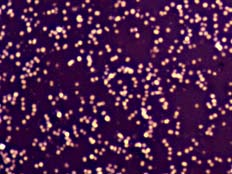Negative Stains
Negative stains are simple stains applied to a non-heat fixed
bacterial sample
Purpose: Negative stains are
used to view cell morphology and arrangement of microorganisms
and selected because of the minimal damage and distortion of the bacterial
structures.
Acidic stains such as Nigrosin are used in the staining process.
The bacterial sample is mixed with the dye on the slide. A second
slide
is used as a spreader to create a film over the entire slide surface. The
sample is then allowed to air dry.
Acidic stains are anionic, that is, they are negatively charged since they
give up a H+.
Bacteria also have a negatively charged surface, so the two negative charges
repell one another.
The bacteria will appear clear against a colored background.
 Negative
stain of cocci shown as clear spheres against a black background.
Negative
stain of cocci shown as clear spheres against a black background.